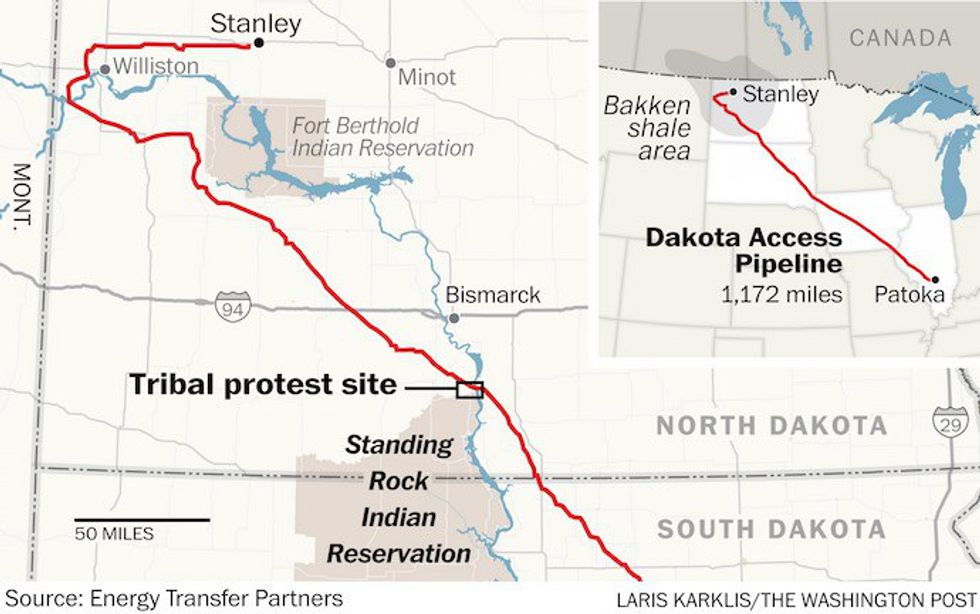Even though it has only been a little over two weeks since Donald Trump was inaugurated as the 45th President of the United States, he has already laid the groundwork for dismantling crucial forces that keep private corporations from destroying sacred sites and polluting clean water. Between freezing EPA grants, implementing a gag order on national agencies, and signing an executive order to approve DAPL and Keystone XL, the new administration has made it clear that they will make it as easy as possible for Big Oil to obtain the permits needed to build pipelines. It will also speed up Trump’s $1 trillion infrastructure plan, in which private investors can earn substantial tax credits. Because let's be frank, the removal of environmental regulations is a developer's wet dream.
To the surprise of very few people, there has been a large public outcry against his policies — protesters took to the streets in solidarity with environmental agencies and the individual workers at the National Park Service, the EPA, and NASA, who defiantly set up separate “rogue” accounts (if you haven't clicked 'follow' yet, you're missing out). While the efforts to zero in on the environmental risks of DAPL is paramount, there has been very little advocacy for (or even talk of) the cultural resource agencies that are central to the lawsuit brought forth by the Standing Rock Sioux Tribe.
For the last four months, I’ve been working at the Department of Archaeology and Historical Preservation (DAHP) for Washington State. Established by the National Historic Preservation Act of 1966, the law called for each state to have a historic preservation office for the purpose of overseeing all projects conducted within the respective states to protect historic properties. The term “properties” here doesn’t just mean buildings and sacred land — it includes human remains. In Washington, human remains that are found to be over 50 years old fall directly under the jurisdiction of the agency. And if the bones are those of a Native American, they are repatriated to the appropriate tribe.
One local instance made national news. In 1996, the most complete set of human bones found in America, dated over 9,000 years old, was discovered in Kennewick, WA. Until this year, the bones were owned by the U.S. Army Corps of Engineers (USACE) and for years, scientists argued over its ethnicity, running test after test. And this whole time, Native American tribes had fought for the right to claim and rebury him on tribal land. Last September, the House and Senate passed a bill that would allow the Kennewick Man to return to a coalition of Columbia Basin tribes for a traditional reburial. On December 16, President Obama ratified the bill, transferring ownership from the USACE to DAHP, who would in turn transfer ownership to the tribes. The entire department was elated to hear that the "Ancient One" would return to his people. Amid the tensions between the Standing Rock Sioux tribe, the USACE, and Energy Transfer Partners, the return of the Kennewick Man was a great example of the respect that can be achieved between the tribes and state agencies.
Unfortunately, sacred land and water may not be as respectfully treated elsewhere, given Trump's sizable investment in Energy Transfer Partners. Therefore, the newly inaugurated president seems hellbent on defunding regulatory agencies and repealing laws that would stand in the way of reckless pipeline development. And though they have not received much media attention, both federal and state cultural resource agencies could be severely endangered with the new administration. After all, they are central to preventing private developers from circumventing laws that allow construction without the input from preservationists and Native American tribes. The National Historic Preservation Act (NHPA) requires federal and state agencies to identify and assess potential impacts to properties of religious and cultural significance, which includes consultations with all Tribal Historic Preservation Officers in a given state. Section 106 requires federal agencies to identify properties already in or eligible for listing in the National Register of Historic Places, as located in the project’s “area of potential effects.”
At the core of the DAPL controversy is the USACE’s evaluation and issuance of multiple water crossing permits, as several agencies questioned whether their conduct was in proper compliance with the Section 106. The Advisory Council of Historical Preservation (ACHP), the only agency with Congressional authority to issue Section 106 regulations, has expressed that the USACE did not fulfill its responsibilities under the NHPA, as a result of its use of Appendix C as a substitute for Section 106. Energy Transfer Partners submitted separate permit applications for each crossing of the Missouri River, totaling over 200. Under Appendix C, the USACE had the ability as a lead agency to determine that each crossing is a separate federal undertaking. Therefore, the entire 1,168 mile pipeline route was not assessed in its entirety, for the purpose of minimizing the project’s Area of Potential Effect to the permit area rather than the full geographic area that could be directly or indirectly damaged. Appendix C also states that tribes may be consulted, but it is not required to approve the permits. The Standing Rock Sioux Tribe subsequently sued the USACE for inappropriately segmenting permits for Section 106 review, failing to fulfill the National Environmental Policy Act (NEPA). In addition, the American Cultural Resource Association released the following statement:
“All stakeholders, including developers of federally permitted projects, Indian tribes, and local communities, must be able to make informed predictions as to how an agency will define the undertaking, how it will identify historic properties within the area affected by the undertaking, and how it will fulfill its responsibility to consult with Indian tribes and other consulting parties in each step of the Section 106 process.”
It is crucial to understand that Native American spirituality is rooted in their environment. Land and water to tribes is as sacred as Bethlehem to Christians. In a sense, it is a cultural issue because it is an environmental issue. Therefore, cultural resource agencies should receive as much support as environmental agencies in the fight against DAPL. We must build an inter-agency coalition achieve success.
On December 4, 2016, after months of peaceful protests and public outcry, the USACE decided to deny easement of the pipeline. It was a small victory, but a victory nonetheless. However, recent actions from the Trump administration has put millions back on edge once more. It has become increasingly clear that the executive branch would be more than willing to discount historical and cultural preservation for the benefit of "national security," in terms of ending reliance on foreign oil, despite the fact that a move towards clean energy would achieve the same goal. There are a number of paths Trump could take to ensure large development projects are met with little resistance. Of course, it won't just stop at the Dakota Access Pipeline. Its approval, along with Keystone XL, will send a message that crude oil is still a profitable and valuable natural resource, opening up the potential for even more harmful drilling. Though Trump opposed the transfer of federal land to state ownership, the Republican Party platform said otherwise. The sale of public land to expand oil and gas development, as well as mining, could be a very real possibility. While this can incur Section 106 review, the Secretary of Interior, who oversees the National Park Service, the Bureau of Land Management, and the Bureau of Reclamation), would have the final say. Trump's pick, Ryan Zinke, is thankfully more moderate than his other cabinet members, but this is still not a win. While he does not deny that the climate is changing, his opinion on the level of human culpability leaves much to be desired. And though he does not favor selling public land, he is certainly not opposed to extraction. Also, federal environmental regulations could be delegated to the states, with the knowledge that many states have not yet passed laws requiring cultural and environmental reviews to issue permits. To make matters worse, the congressional authorization of the Historic Preservation Fund expired in September 2015, and it has little chance of inclusion in Trump’s budget plan. This fund supports both State and Tribal Historic Preservation Offices, and if federal funding is pulled, these agencies could face massive cuts. This uncertainty has been hanging over our heads at our department for some time now. Though the effect would not take place immediately, it will take just as long to reverse whatever Trump puts forth.
But hope is not lost. Thanks to the tireless efforts of environmental and cultural resource agencies, tribal nations, and water protectors, USACE has filed a notice of intent to complete an Environmental Impact Statement for an easement that would allow DAPL to cross the Missouri River under the Lake Oahe reservoir – and they are now accepting comments from the public! From my experience working at DAHP, these comments count more than you think in determining the fate of a project. Use your citizen power here. The public comment period ends February 20, 2017.
Watch the American Cultural Resources Association's video on Cultural Resource Management in the Age of Trump here. Read the transcript here.
Read the National Park Service's Cultural Resources Climate Change Survey here.






























